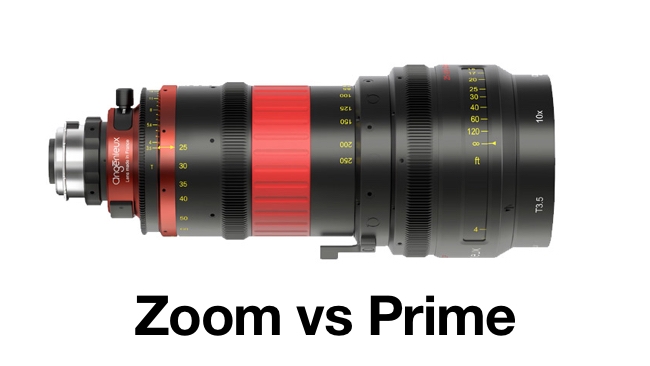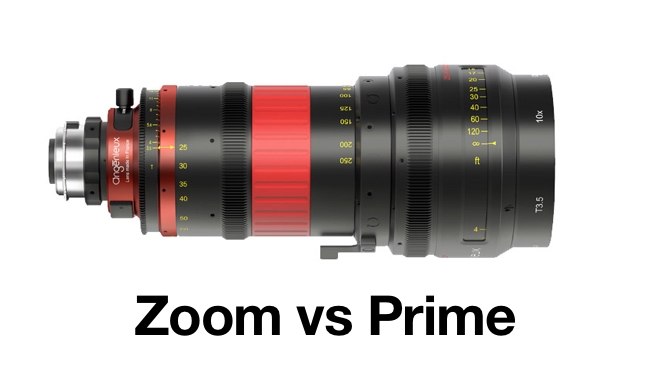
 Zoom vs Prime
Zoom vs Prime
Replay: One of the surprising things over the last decade television and video has been the rise of the fixed focal length, prime lens. What does it mean for the future of the zoom lens?
For over three decades, zoom lenses have been the standard in television, not only in the studio, but in single camera work: Fuji or Canon on B4-mount video cameras, Zeiss, Angenieux or Canon zooms on 16mm cameras. Prime lenses were largely a thing of the past except, in the case of film, for Zeiss Distagons in low-light situations or extra wide or extra long lenses. Prime lenses for B4 mounts were almost unknown. Often on location, you would take a wide-angle zoom in addition to the regular zoom, but those two lenses would get you through the day.
Compared to a prime, zoom lenses have always been a comprise; they suffer in terms of speed (maximum aperture), size and weight, sharpness, 'breathing' (the zoom effect when pulling focus) or minimum focus distance. But they got pretty good. Back in the days of Super 16mm, my regular kit was a Canon 8-64mm T2.4 and Zeiss 12-120mm T2.4. The Canon was a fantastic lens for documentary work - wide enough, sharp enough and with minimal breathing - and it was good for drama, too.
So what happened?
Firstly, as we all know, sensors got bigger and resolution increased. A wide zoom lens to cover a Super 35 sensor is very big and very expensive. There are no real equivalents to my old Canon 8-64mm, but an Optimo 16-42mm T2.8, with a slighter wider maximum angle, but significantly shorter zoom range, would set you back over £30k. And most of the previous generation of zoom lenses simply aren't up to scratch in terms of resolving power when you have a 4K or even an HD sensor.
Secondly, the DSLR revolution got a whole generation used to using primes. It opened up the possibility of using a wide range of mass produced, high quality, inexpensive lenses for HD video. Even if you choose zoom lenses, those designed for stills never have the range of video zooms so, inevitably, you get accustomed to changing lenses. The DSLR also encourages an approach to documentary where shots are set-up for the camera, rather than the camera following the action, perhaps favouring aesthetics over content.
Thirdly, zooming-in-shot went out of fashion - it now looks cheap. Many great movies of the 70s and 80s, when the zoom lens was an innovation, are full of dramatic zooms (look at the films of Sergio Leone and Nic Roeg). When amateur video cameras with zoom lenses became commonplace, zooms began to look tacky. Or perhaps 'contrived' is a better word: our eyes have no equivalent to the zoom effect, whereas a tracking shot is how we see when we move through space. In a tracking shot, the perspective changes, unlike a zoom where the perspective remains the same - it's the equivalent to moving in on a still photograph.
Tracking and crane shots have more emotional impact and exude 'production value'. As cameras have gotten lighter, moving the camera smoothly has become easier and technology has given us a host of new ways to do it: the Steadicam, lightweight dollies, remote heads and now gimbal systems and drones.
Zoom defence
A zoom is not a substitute for moving the camera, but even if you want to avoid zooming in shot as much as possible, zooms are an essential tool for most documentary work. Not only does it mean you don't have to change lenses frequently, but you can quickly reframe during a sequence to give an editor a choice of shots. It enables you to cover action wide and yet zoom in and pick up on details of faces or actions that are essential to telling the story.
Perhaps there is a little bit of mystique in the prime lens. There are those who think there is some magic in the glass, that if they just get the right set of lenses, their work will have a special look. Let me disillusion you; is a £35k set of Cooke primes much better than £1k set of Samyang lenses? Yes, of course it is, without a doubt, but it isn't 35 times better. And it really isn't just about 'the look' (of course, that's part of it) - high-end kit earns its price tag for reliability, robustness and consistency. You know the lenses are going to match each other, the markings will be accurate and easy to read, the kit will fit together properly and it won't break down. The crew will be familiar with it, the shoot will go smoothly and the resulting images will be what everyone expected. The economics are obvious: the larger the crew, the more it's worth to pay for a kit everyone is confident in, as every minute's delay costs money.
Really, the magic is not in glass, it's in what you do with it. Obviously, you need lenses that are sharp enough to resolve for your format (if a lens is soft to start with, there's really nothing you can do about it), but as far as drama is concerned, how you light is much more important than the particular brand of lens; that is where 'the look' primarily comes from. And with documentary, getting the shots you need to tell the story is really what matters.
Maybe it's time for a zoom revival. Despite their low-budget connotations and the fact they don't look 'natural', they still have their place. Here's a 45 second celebration of the zoom I found on the net. It culminates in the classic zoom-out combined with a track-in which Hitchcock pioneered in Vertigo. Enjoy!
(Warning: Strong language at the end of the clip. Don't watch this if you don't like the word "******")
Tags: Production


Comments